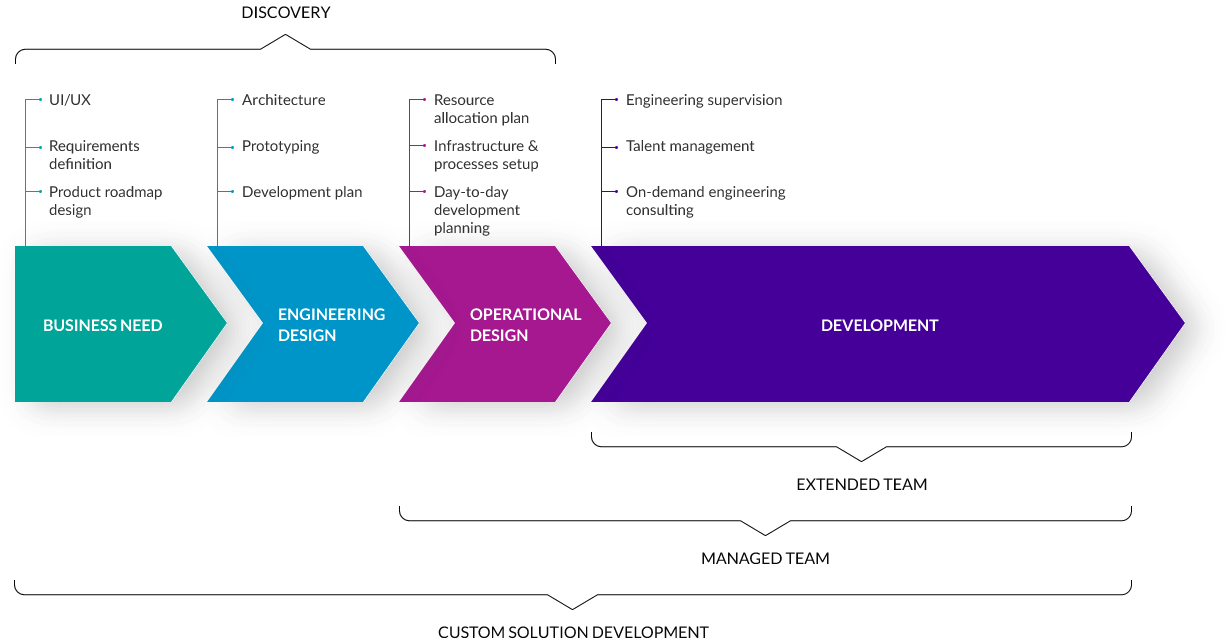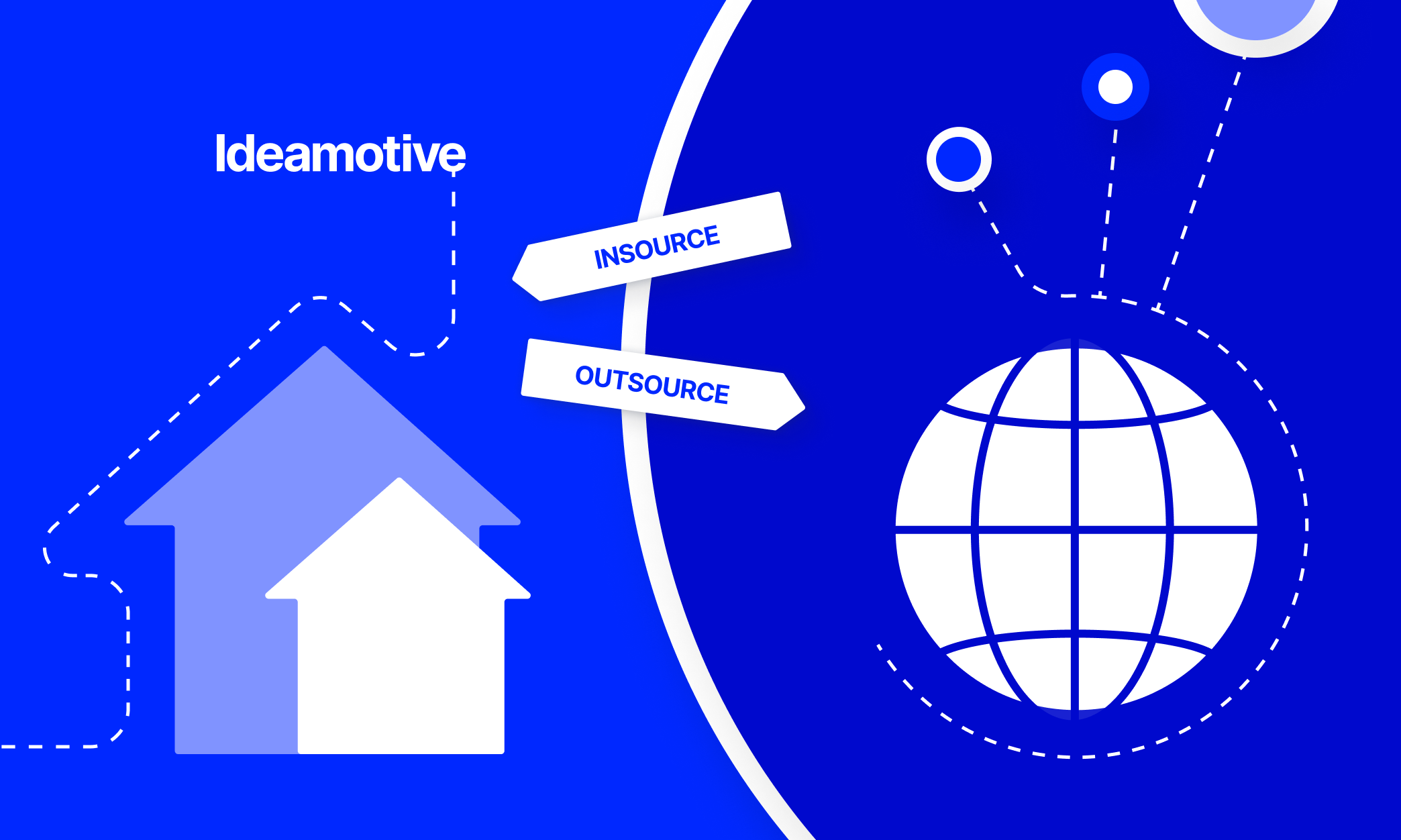IT project outsourcing is a path that is not fully explored by business owners. This is because the real and perceived threats associated with this recruitment model are little known.
While there are many negative stereotypes about outsourcing, such as the loss of managerial control, this business model has become widespread in both private and public organizations.
First, it allows enterprises to achieve their business goals cost-effectively due to low labor costs in overseas markets. In addition, it allows you to leverage experience and performance at a level that the in-house team might not be able to match.
In this article, we'll look at the overall outsourcing market, the factors that have led to the industry's dramatic growth, and outsourcing tips for a software development project.
But first…
What is outsourcing?
Outsourcing is a business practice in which a company hires a foreign or local person or company to provide services that are usually or have previously been performed by their own team.
Under such a working arrangement, the hired service provider remains responsible for its workforce and computer systems to deliver the expected services, either on-site or offsite.
While offshoring and nearshoring are interchangeable, there is a fundamental difference between them. A closer look at the definition of offshore outsourcing will reveal some glaring differences.
Nearshore outsourcing is the "young offspring" of offshoring as it involves hiring a service provider a little closer to home, even if they may still be located in another country or region.
On the other hand, offshoring means moving business processes to a remote location.
Now that we've managed to iron out the main differences between the two, let's take a quick look at when one should leverage it.
When should you outsource IT services?
Choosing to partner with remote programmers is a tough decision for any business. However, there are a few clear signs that it's time to outsource software development.
- Lack of internal talent. Too many tasks can quickly make your team feel overwhelmed. Through outsourcing, you can easily increase your overall speed and delegate some tasks to a third-party team.
- Difficulty finding the right talent. If you spend weeks or even months looking for a candidate with the required skill set, this is a clear sign that you need to broaden your search. As stated in our IT outsourcing report, this method gives you access to a huge talent pool where you can quickly find suitable candidates. Moreover, experienced IT outsourcing providers usually have a large recruiting team and an impressive internal candidate base.
- Carryovers and failed deadlines. Regularly meeting deadlines is essential to the success of any project. For example, if your team is struggling to keep up with your machine learning project’s roadmap, scaling up or adding a separate team of Python developers might be the solution you're looking for.
- Difficulties in solving complex projects. An experienced outsourcing partner can provide the necessary knowledge to develop any project, no matter how complex it is.
- Lack of technical knowledge. With software project outsourcing, you can bring your idea to life even if you don't have technical knowledge. The right partner can take care of the complete development of your project, from the initial feasibility study to development, customization, and support.
- It is necessary to optimize costs. An experienced vendor can help you implement the best development practices (choosing the best technology stack, architecture, DevOps optimization, software testing, etc.) while optimizing costs. In addition, such a partnership will help you avoid the overhead costs of recruitment, personnel management, and administration since all these tasks are performed by your outsourced service provider.
Find more insights on when and how to outsource IT with the help of our webinar.
10 best practices in outsourcing project work
1. Determine the goals and scope of outsourcing
If you don't know where you are going, you will never get there. Once you have decided to start an outsourcing project, you need to decide what exactly you want to outsource. Analyze your project to see what you can do on your own and what skills you don't have.
For a successful outsourcing strategy, it is very important to:
- define both long-term and short-term requirements;
- make sure you have a clear understanding of the software development project you are outsourcing;
- prepare written responsibilities and expectations for your overseas team.
Be prepared to answer a few questions about a future software product from your potential outsourcing company. The right contractor bombards you with questions about your business and project goals, tries to clarify as many requirements and expectations as possible before the project goes live, and goes to great lengths to understand the unique nature of the project.
The more information you provide to the supplier, the better they can estimate the size and cost of your project, align their processes with yours, and select the most appropriate development methodology. Without clear goals, clearly defined scope, and responsibilities, your involvement in outsourcing can be like a blind man leading the blind.
And never outsource activities that are unique to your business, your core functions, and strategic initiatives. The most successful option is to maintain adequate internal control over critical business functions, leaving non-core competencies to outsourcing providers.
2. Choose the right supplier
To establish an effective IT project outsourcing management process, you first need to find the right provider. And the best supplier is a service provider that not only understands your industry but is fully aligned with your business goals and culture. Thus, by spending a little more time choosing a foreign partner, you can save yourself a lot of problems in the future. Therefore, do your research.
First, select at least 5 promising outsourcing development companies and IT marketplaces. Compare the range of services, benefits, and perks they offer and explore in detail the personality of your providers. Take a look at their culture and values, processes, and approaches to get a clear picture of the companies. Look for a proven track record - check Clutch testimonials of satisfied clients.
Then you need to carefully analyze and list the suppliers.
Your checklist should look like the following one:
- Provider Service models and collaboration approaches
- Areas of expertise
- Portfolio of previous projects
- Customer reviews
- Clutch reviews
Whether you're outsourcing design, software development, or quality assurance, it makes sense to review the work of anyone you're going to work with. Also, feel free to request a resume from each individual developer or any other member of the offshore team to ensure you hire the very best talent.
Bonus: In case you feel like all these recommendations work for you look no further than IT marketplaces. There you’ll have the ability to compose a team in pieces (from every developer to managers).
3. Focus on value, not cost
Yes, outsourcing can save you money, but that's not the only reason why you've turned to it. Never think of outsourcing as a cheap and easy way to offload work. Outsourcing should optimize your business to free up time for strategic purposes.
Your outsourcing company's rates are often a reflection of skills, experience, and quality of work.
Supplier A, for example, might have a $20 per hour rate but staff the project with a large number of junior developers with limited experience. Vendor B could have $50/hour rates and staff the project with 3 times fewer JavaScript developers, using more experienced people who take less time to complete certain tasks.
Which one will be more productive and bring more value to your project?
4. Choose the right model for IT project outsourcing
There are three models of cooperation in the development of outsourced software projects, each of which has its own characteristics. It is important to choose the one that best suits your business needs.
Extended team (or outstaffing)
This model is well suited if you need to expand your core engineering team with additional developers or experts with specific technical expertise. For example to add several Ruby on Rails developers or React coders. They integrate with your development processes and communicate with you daily. As a result, you have a good sense of control as management, task assignment, and progress tracking are all done on your side.
The extended team model is valued for its high flexibility to scale up or down. However, this usually requires a longer recruitment process as you have to participate in the interview and evaluation of each candidate. In addition, it requires effective communication and knowledge sharing with your outsourcing team.
Such actions require more effort on your part. Therefore, it often makes sense to delegate them to your outsourcing team as well. A trusted technical partner near you can take care of recruiting, interviewing candidates, day-to-day team management, and technical guidance, allowing you to focus on your core business tasks.
In addition to taking the burden off you, it also creates opportunities to form more advanced and long-term partnerships.
| Pros |
Cons |
| More capacity added to your engineering team |
Slower staffing process |
| Access to large talent pools that can fill any gap in technical expertise |
More effort required for knowledge sharing and retention |
| Flexible scaling up or down |
Management overhead |
Managed team
Choose this IT project outsourcing model if you need to delegate some of your product development to a separate, self-sufficient engineering team integrated into your supply organization. The size and composition of the team are tailored to the specific requirements of your project. Your outsourcing partner also provides a dedicated project manager who takes care of day-to-day management and ensures that the team works well. As a result, managed teams require less input from you, and business reports and reviews are produced quarterly on average.
The biggest advantage of a managed team is its ability to work as a separate unit, yet be integrated into your delivery process. Building such a team is faster as the entire hiring process is outsourced to your partner. In the case of Ideamotive’s tech talent marketplace, for example, it takes about 4-6 weeks to fill a vacancy with the right talent. Moreover, such teams always have a dedicated project manager who monitors their performance, progress, and daily processes. IT outsourcing project management is another level of your progress.
This partnership lasts longer than an extended team and can bring more benefits. Indeed, such projects usually have a high employee retention rate, which allows you to get teams that will provide long-term support to your company.
In addition, these partnerships often develop over time as the managed group takes on new responsibilities. With years of knowledge and experience, these teams can provide valuable advice on the best practices and technologies that can improve your project. In a way, they become your personal IT consultant, making sure you stay up to date with the latest technology trends.
| Pros |
Cons |
| A self-sufficient team integrated with your delivery organization |
Needs clear requirements, roadmap, and documentation |
| Management and technical guidance handled by a dedicated expert |
Requires a dedicated person/team for regular communication |
| Quick recruitment process and team formation |
|
Development of custom solutions
While the extended team and managed team models work on a project-by-project basis, custom solution development works business-wide.
This model is best used to solve business challenges such as expanding market coverage, digital transformation, or developing full-fledged products. This is especially useful for companies that want to focus on other aspects of their business and are looking for a partner who can take full responsibility for their problem or need.
Custom development includes a full cycle of design and development of the project. It begins with an extensive discovery phase performed by business analysts, system architects, technical leads, and other experts. The team conducts a detailed analysis of your business and internal processes to validate your idea, select the best stack and architectural design, and provide you with all the results you need to successfully launch your project. In addition, they may also research your competition and the market you operate in.
After the discovery phase, your outsourcing partner will make sure to hire the best people for your project and provide a workspace for your team to focus solely on your project. The project is managed by a dedicated PM who regularly shares progress updates, milestones, and releases to keep you updated on the development status.
Such partnerships often develop into entire offshore R&D centers that become an integral part of your company. They help you scale your business, expand your customer reach, and accelerate digitalization.
| Pros |
Cons |
| End-to-end solution delivery: from vision to product |
Less cost-effective for short-term projects |
| A Discovery phase helps mitigate risks, optimize costs, and test product concept |
|
| Does not need clearly defined requirements or regular guidance |
|
Overall the roadmap looks like this:

5. Discuss project development time and cost
Once you've decided on a software company for your next project, it's time to discuss the cost and time of the project and clear things up. You need to clearly discuss everything, including your pricing model and all other costs. If everything is transparent and negotiable, such as app development cost, duration, delivery, and release date, among other factors, you can move on.
6. Start with a pilot project
Before hiring a development team, you need to be sure of their capabilities. Start by asking the team to work on a test project. Their functionality and performance can help you decide if you want to keep using them.
Here's what you can learn about your outsourcing team from this pilot project:
- Authenticity. Is your outsourcing partner honest and open about their procedures? Can they deliver on projects as promised?
- Communication skills. Does the outsourcing partner ask the right questions? Can they effectively follow all your instructions?
- Time management. Does the outsourcing team meet its internal deadlines? Will they be able to hand in the work on time?
Running a pilot project may require you to invest resources and time. However, it will help you get a clear idea of what the collaboration experience will be like.
7. Sync up regularly
Agree in advance to receive updates on a fixed schedule. Synchronization can be daily or weekly, but be disciplined about keeping the agreed time, especially if your outsourcing team is in a different time zone.
Effective communication, especially with new or remote employees, is the key to creating a more efficient, productive, and profitable project. Whether you use Google Chat or Slack, centralized storage of all project communications will increase accountability and allow all team members to communicate in real-time.
8. Concerns about confidential data
If the service provider needs access to some sensitive data, we recommend that you increase the privacy and security reservations you may have.
In this case, it is better to avoid a private freelancer and choose an enterprise-type solution.
While a freelancer may be truly honest and trustworthy, their systems and networks may not be as sophisticated as those of a full-fledged company.
9. Don't forget post-development support
For software development projects, it is always good to have a support clause or warranty if you want to be sure of continued support from the service provider after the project is completed.
As a general rule, always agree on a support clause after development before work begins.
Finally, you need to specify whether future modifications will be available for free or at a discount. This will save you time, money, and headaches later on.
10. Prepare your on-site team
When you start outsourcing, your company is going to accept many changes in management and organizational structure. Your teams will be extended with an offshore team that can operate across multiple time zones.
Thus, you must prepare your internal team to work effectively with their new remote colleagues. Do this as early as possible and make sure everyone in your organization agrees to this change.
How to avoid IT project outsourcing failures
Like anything in this world the discussed approach also has its downsides. However, there is a clear strategy on how to circumvent top IT outsourcing challenges.
Treat every outsourced member of your team with respect
Spend some time getting to know the members of your team. Whether by videoconference or other means, put faces in front of names and find out what drives them. Takeaway: Treat your outsourcing team like the partner you expect them to be.
Seek to distribute certain risks
At times, as a business owner or a CEO, you may occasionally encounter small, day-to-day tasks that you don't enjoy doing. However, if it is a technical task that you know nothing about or absolutely hate, you can try outsourcing it.
There is a high probability that such a task will take you a lot of time and energy, which would take less time for a qualified specialist.
Set up the right controls
To grow your business, you must spend more time building it than running it. However, you will have to put some time and effort into managing your outsourcing team.
A significant advantage is that your outsourcing company provides project management services.
Wrapping up
All in all, while there will always be challenges and difficulties along the way to a successful business project outsourcing, like any other business, the benefits outweigh the risks for many companies.
Highly qualified specialized offshore developers can provide faster, cheaper, and easier development of your project, especially in post-Covid times. Understanding the risks and having an offshore outsourcing strategy in place provides a roadmap for the success of your business.
No doubt, by using these tips, you can avoid common outsourcing failures and reap the benefits of this practice.






.png)



